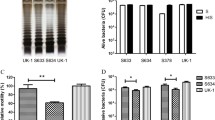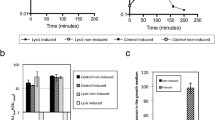Abstract
Some anaerobes and facultative anaerobes have been used in tumor-specific gene therapy by reason of their selective growth in tumors. In this work, we aimed to evaluate the anticancer efficacy of attenuated Salmonella typhimurium as a carrier to deliver the Escherichia coli purine nucleoside phosphorylase (ePNP) gene for GDEPT (gene-directed enzyme-prodrug therapy). A live attenuated purine-auxotrophic strain of S. typhimurium (SC36) was used to carry the pEGFP-C1-ePNP vector that contains a green fluorescent protein (GFP) and an ePNP gene under the control of the human cytomegalovirus (CMV) promoter. The function of the ePNP expression vector was confirmed in vitro using the enzymic conversion of 6-methylpurine 2′-deoxyriboside (MePdR) into 6-methylpurine. We also observed a high bystander effect induced by the ePNP/MePdR system with a very low proportion (1%) of ePNP-positive cells. The killing effect and increased apoptosis induced by SC/ePNP (SC36 carrying the ePNP expression vector) infection were detected by cytotoxicity assay and PI staining flow cytometry analysis, in combination with MePdR administration. Furthermore, SC/ePNP was administered orally into mice bearing melanomas or pulmonary tumors, and its anti-tumor effect was evaluated. When the tumor was huge (500 mm3) at the beginning of MePdR administration, SC/ePNP plus MepdR significantly inhibited tumor growth by about 59–80% and prolonged survival of mice. Complete tumor regression and long-term cure were achieved by MePdR administration, even when the tumor was large (100 mm3) at the beginning of MePdR treatment. Our data support a hopeful view that tumor-targeting SC36 could improve antitumor efficacy of the ePNP/MePdR system due to its preferential accumulation and anticancer activity in tumors.








Similar content being viewed by others
References
Sarkar D, Su ZZ, Vozhilla N, Park ES, Gupta P, Fisher PB . Dual cancer-specific targeting strategy cures primary and distant breast carcinomas in nude mice. Proc Natl Acad Sci USA 2005; 102: 14034–14039.
Pawelek JM, Low KB, Bermudes D . Tumor-targeted Salmonella as a novel anticancer vector. Cancer Res 1997; 57: 4537–4544.
Low KB, Ittensohn M, Le T, Platt J, Sodi S, Amoss M et al. Lipid A mutant Salmonella with suppressed virulence and TNFα induction retain tumor-targeting in vivo. Nat Biotechnol 1999; 17: 37–41.
Pawelek JM, Low KB, Bermudes D . Bacteria as tumour-targeting vectors. Lancet Oncol 2003; 4: 548–556.
Clairmont C, Lee KC, Pike J, Ittensohn M, Low KB, Pawelek J et al. Biodistribution and genetic stability of the novel antitumor agent VNP20009, a genetically modified strain of Salmonella typhimurium. J Infect Dis 2000; 181: 1996–2002.
Steven A, Rosenberg SA, Spiess PJ, Kleiner DE . Antitumor effects in mice of the intravenous injection of attenuated Salmonella typhimurium. J Immunother 2002; 25: 218–225.
Saltzman DA, Katsanis E, Heise CP, Hasz DE, Vigdorovich V, Kelly SM et al. Antitumor mechanisms of attenuated Salmonella typhimurium containing the gene for human interleukin-2: a novel antitumor agent? J Ped Surg 1997; 32: 301–306.
Sorscher EJ, Peng S, Bebok Z, Allan PW, Bennett Jr LL, Parker WB . Tumor cell bystander killing in colonic carcinoma utilizing the E. coli Deo D gene and generation of toxic purines. Gene Ther 1994; 1: 233–238.
Jensen KF, Nygaard P . Purine nucleoside phosphorylase from Escherichia coli and Salmonella typhimurium. Purification and some properties. Eur J Biochem 1975; 51: 253–265.
Ealick SE, Greenhough TJ, Babu YS, Carter DC, Cook WJ, Rule SA et al. Three-dimensional structure of human erythrocytic purine nucleoside phosphorylase at 3.2 A resolution. J Biol Chem 1990; 265: 1812–1820.
Mao C, Cook WJ, Zhou M, Koszalka GW, Krenitsky TA, Ealick SE . The crystal structure of Escherichiacoli purine nucleoside phosphorylase: a comparison with the human enzyme reveals a conserved topology. Structure 1997; 5: 1373–1383.
Secrist III JA, Parker WB, Allan PW, Bennett Jr LL, Waud WR, Truss JW et al. Gene therapy of cancer: activation of nucleoside prodrugs with E. coli purine nucleoside phosphorylase. Nucleosides Nucleotides 1999; 18: 745–757.
Bzowska A, Kulikowska E, Shugar D . Purine nucleoside phosphorylases: properties, functions and clinical aspects. Pharmacol Ther 2000; 88: 349–425.
Hughes B, Parker WB, Gadi VK, Garver RI, Sorscher EJ . Tumor specific killing with high bystander toxicity using the human tyrosinase promoter to express the E. coli PNP gene. Cancer Res 1995; 55: 3339–3345.
Lockett LJ, Molloy PL, Russell PJ, Both GW . Relative efficiency of tumor cell killing in vitro by two enzyme-prodrug systems delivered by identical adenovirus vectors. Clin Cancer Res 1997; 3: 2075–2080.
Park BJ, Brown CK, Hu Y, Alexander HR, Horti J, Raje S et al. Augmentation of melanoma-specific gene expression using a tandem melanocyte-specific enhancer results in increased cytotoxicity of the purine nucleoside phosphorylase gene in melanoma. Hum Gene Ther 1999; 10: 889–898.
Gadi VK, Alexander SD, Kudlow JE, Allan P, Parker WB, Sorscher EJ . In vivo sensitization of ovarian tumors to chemotherapy by expression of E. coli purine nucleoside phosphorylase in a small fraction of tumor cells. Gene Ther 2000; 7: 1738–1743.
Krohne TU, Shankara S, Geissler M, Roberts BL, Wands JR, Blum HE et al. Mechanisms of cell death induced by suicide genes encoding purine nucleoside phosphorylase and thymidine kinase in human hepatocellular carcinoma cells in vitro. Hepatology 2001; 34: 511–518.
Da Costa L, Jen J, He TC, Kinzler KW, Vogelstein B . Converting cancer genes into killer genes. Proc Natl Acad Sci 1996; 93: 4192–4196.
Nestler U, Heinkelein M, Lucke M, Meixensberger J, Scheurlen W, Kretschmer A et al. Foamy virus vectors for suicide gene therapy. Gene Ther 1997; 4: 1270–1277.
Parker WB, King SA, Allan PW, Bennett Jr LL, Secrist III JA, Montgomery JA et al. In vivo gene therapy of cancer with E. coli purine nucleoside phosphorylase. Hum Gene Ther 1997; 8: 1637–1644.
Hughes BW, King SA, Allan PW, Parker WB, Sorscher EJ . Cell to cell contact is not required for bystander cell killing by E. coli purine nucleoside phosphorylase. J Biol Chem 1998; 273: 2322–2328.
Bharara S, Sorscher EJ, Gillespie GY, Lindsey JR, Hong JS, Curlee KV et al. Antibiotic-mediated chemoprotection enhances adaptation of E. coli PNP for herpes simplex virus based glioma therapy. Hum Gene Ther 2005; 16: 1–9.
Martiniello-Wilks R, Dane A, Jeyakumar G, Mortensen E, Shaw JM, Wang X-Y et al. Gene-directed enzyme prodrug therapy for prostate cancer in a mouse model that imitates the development of human disease. J Gene Med 2004; 6: 43–54.
Hughes BW, Wells AH, Bebok Z, Gadi VK, Garver Jr RI, Parker WB et al. Bystander killing of melanoma cells using the human tyrosinase promoter to express the Escherichia coli purine nucleoside phosphorylase gene. Cancer Res 1995; 55: 3339–3345.
Deharvengt S, Wack S, Uhring M, Aprahamian M, Hajri A . Suicide gene/prodrug therapy for pancreatic adenocarcinoma by E. coli purine nucleoside phosphorylase and 6-methylpurine 2′-deoxyriboside. Pancreas 2004; 28: e54–e64.
Deharvengt S, Wack S, Aprahamian M, Hajri A . Transcriptional tumor-selective promoter targeting of E. coli purine nucleoside phosphorylase for pancreatic cancer suicide gene therapy. J Gene Med 2005; 7: 672–680.
Cai X, Zhou J, Lin J, Sun X, Xue X, Li C . Experimental studies on PNP suicide gene therapy of hepatoma. J Huazhong Univ Sci Technolog Med Sci 2005; 25: 178–181.
Cai XK, Zhou JL, Zhou HJ, Zhang L, Wu JH, Lin JS . Killing effect of PNP/MeP-dR suicide gene system driven by an AFP promoter AF0.3 on AFP-positive hepatoma cells. Ai Zheng 2006; 25: 1334–1339. Chinese.
Kikuchi E, Menendez S, Ozu C, Ohori M, Cordon-Cardo C, Logg CR et al. Delivery of replication-competent retrovirus expressing Escherichia coli purine nucleoside phosphorylase increases the metabolism of the prodrug, fludarabine phosphate and suppresses the growth of bladder tumor xenografts. Cancer Gene Ther 2007; 14: 279–286.
Graves LM, Swaminathan B . Universal bacterial DNA isolation procedure. In: Persing DH, Smith TR, Tenover FC, White TJ (eds). Diagnostic Molecular Microbiology, Washington: American Society for Microbiology, 1993, pp 617–621.
Roth JR . Genetic techniques in studies of bacterial metabolism. Methods Enzymol 1970; 17: 3–35.
Tong G, Wenzhou L, Shenghua L, **aohui L, Daming R, Xuhui H et al. Enzymatic synthesis of 6-methylpurine-20-deoxyriboside by recombinant purine nucleoside phosphorylase. Ind Microbiol 2007; 37: 8–13.
Mosmann T . Rapid colorimetric assay for cellular growth and survival: application to proliferation and cytotoxicity assays. J Immunol Methods 1983; 65: 55.
Sasaki DT, Dumas SE, Engleman EG . Discrimination of viable and non-viable cells using propidium iodide in two color immunofluorescence. Cytometry 1987; 8: 413–420.
Tanaka T, Kanai F, Okabe S, Yoshida Y, Wakimoto H, Hamada H et al. Adenovirus-mediated prodrug gene therapy for carcinoembryonic antigenproducing human gastric carcinoma cells in vitro. Cancer Res 1996; 56: 1341–1345.
Theys J, Landuyt W, Nuyts S, Van Mellaert L, van Oosterom A, Lambin P et al. Specific targeting of cytosine deaminase to solid tumors by engineered Clostridiumacetobutylicum. Cancer Gene Ther 2001; 8: 294–297.
Li X, Fu GF, Fan YR, Liu WH, Liu XJ, Wang JJ et al. Bifidobacterium adolescentis as a delivery system of endostatin for cancer gene therapy: selective inhibitor of angiogenesis and hypoxic tumor growth. Cancer Gene Ther 2003; 10: 105–111.
Schoen C, Stritzker J, Goebel W, Pilgrim S . Bacteria as DNA vaccine carriers for genetic immunization. Int J Med Microbiol 2004; 294: 319–335.
Brown SP, Cornell SJ, Sheppard M, Grant AJ, Maskell DJ, Grenfell BT et al. Intracellular demography and the dynamics of Salmonella enterica infections. PLoS Biol 2006; 4: e349.
Gadi VK, Alexander SD, Waud WR, Allan PW, Parker WB, Sorscher EJ . A long-acting suicide gene toxin, 6-methylpurine, inhibits slow growing tumors after a single administration. J Pharmacol Exp Ther 2003; 304: 1280–1284.
Dunstan SJ, Simmons CP, Strugnell RA . In vitro and in vivo stability of recombinant plasmids in a vaccine strain of Salmonella enterica var. typhimurium. FEMS Immunol Med Microbiol 2003; 37: 111–119.
Lee CH, Wu CL, Shiau AL . Endostatin gene therapy delivered by Salmonellacholeraesuis in murine tumor models. J Gene Med 2004; 6: 1382–1393.
Platt J, Sodi S, Kelley M, Rockwell S, Bermudes D, Low KB et al. Antitumour effects of genetically engineered Salmonella in combination with radiation. Eur J Cancer 2000; 36: 2397–2402.
Mengesha A, Dubois L, Lambin P, Landuyt W, Chiu RK, Wouters BG et al. Development of a flexible and potent hypoxia-inducible promoter for tumor-targeted gene expression in attenuated Salmonella. Cancer Biol Ther 2006; 5: 1120–1128.
Acknowledgements
We thank State Key Lab of Genetic Engineering of Fudan University for technical assistance. Thanks a lot to Professor Chaoqun Wu, Mr Jiachi Liu and Mr James Andrew Worley for hel** us to amend the article.
Author information
Authors and Affiliations
Corresponding author
Rights and permissions
About this article
Cite this article
Fu, W., Lan, H., Li, S. et al. Synergistic antitumor efficacy of suicide/ePNP gene and 6-methylpurine 2′-deoxyriboside via Salmonella against murine tumors. Cancer Gene Ther 15, 474–484 (2008). https://doi.org/10.1038/cgt.2008.19
Received:
Revised:
Accepted:
Published:
Issue Date:
DOI: https://doi.org/10.1038/cgt.2008.19
- Springer Nature America, Inc.
Keywords
This article is cited by
-
Targeting purine metabolism in ovarian cancer
Journal of Ovarian Research (2022)
-
Tumour-targeting bacteria engineered to fight cancer
Nature Reviews Cancer (2018)
-
Engineering Salmonella as intracellular factory for effective killing of tumour cells
Scientific Reports (2016)
-
Tumor-targeting Salmonella typhimurium, a natural tool for activation of prodrug 6MePdR and their combination therapy in murine melanoma model
Applied Microbiology and Biotechnology (2013)
-
Engineering the perfect (bacterial) cancer therapy
Nature Reviews Cancer (2010)




